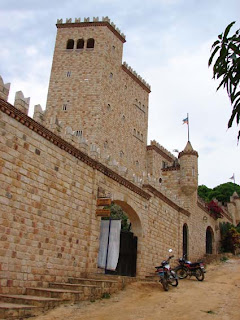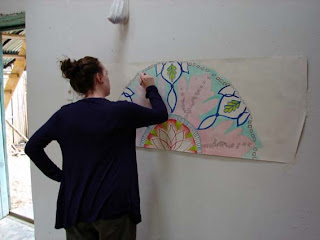Since we last posted our blog we have spent a week in Chazuta, a nearby town, where we have taken part in workshops in ceramics and natural paper making, collected stones from the river to make natural pigments and spent time with the women at Mishki Cacao (a local organic chocolate makers).
This has been an invaluable experience and given us insight into traditional crafts, heritage and customs from the San Martin region. Spending time with the local women has given us a huge amount of inspiration for creating our own work and allowed us to gain in depth knowledge of the history and skills involved in each craft as well as the cultural intangible heritage attached to each one (such as dances and songs relating to the processes etc). These groups are not yet on the tourism map, although with their passion and drive it may not be long before they begin exporting their goods. It was interesting to observe how these businesses with very little money located in a very remote area, on the fringe of the Amazon rainforest can operate as they deal with sporadic water and electricity supply and main transport route still under construction. Our workshops were organised by Sachaqa Arts Centre who are our main partners within the Transporter project so it is good to see these types of links being made across the region of San Martin as a benefit to both the arts centre and the local craft groups/businesses.
We discussed a great deal about developing businesses and how to be sustainable (both economically and environmentally) whilst keeping true to roots. We all learnt a great deal, but in different ways. We were able to offer advice on marketing, networking and sharing resources whilst their processes highlighted how much waste there is in the West; they are very creative with the resources they have, every bit of a cacao bean can be used for something as can the banana tree. Even shop displays, signage and decoration are handmade so there is a real sense of individuality to buildings and property- something Britain has unfortunately lost on mass. We saw a big difference between Chazuta and San Roque de Cumbaza (where our residency is based) and felt this experience has been essential to understanding two very different communities. Chazuta felt more like a working town with a harbour, people making fishing nets and spinning cotton on the streets.
We have uploaded a range of images and videos from our time in Chazuta which gives a guide to the processes for each craft as well as photos from other things we have seen –http://www.flickr.com/TRANSPORTERproject
Ceramics – Chazuta is famous for its ceramics and the women who taught us over the week, many of whom are in their 80s, have been creating ceramics since childhood. The craft is extremely important to them as a way of life, as it was borne out of necessity to make pots to hold food and drink and now it is also a way to make money to provide for their families. They are currently building a ceramics museum next to the studio, to show both ancestral and contemporary ceramics and to display ceramic burial tombs from an archaeological dig. The difference between ceramics from Chazuta and Lamas areas was discussed; Lamas who create less decorative, more practical pottery whilst the Chazuta ceramicists are experimenting with techniques and developing new styles and iconography for their creations. This posed interesting questions surrounding when pottery for practical purposes becomes art? Something we are going to explore further with our own art work.
Paper making – This group of 6 people, 1 man and 5 women make paper from natural materials such as banana plants, coconut shells and leaves, sugar cane and various other trees. They were taught the process by someone from America who visited them 10yrs ago. Since then they have built their own studio and have orders from Lima and Tarapoto. It is a very labour intensive process and no machinery is used. They have a garden where they grow banana trees to replace the ones they cut down. They take about a year grow again to bear fruit and use for the paper making process.
Mishki Cacao – formed in 2009 and became officially a company in 2011. Mishki means ‘sweet’ in Quechua (an indigenous language of Peru which is still spoken by many in Chazuta). This was a strong family connected business where the husbands organically farmed the cocao bean and 13 women naturally processed it into the most beautiful chocolate we’ve ever tasted! The women even had songs they sang about empowerment and their passion for their craft was inspiring.
Before coming to Peru we made contact with Allpa, an organisation that distributes Peruvian handmade crafts to buyers across the world with a focus on environmentally friendly and fair-trade products, and so we are due to meet them on our return to Lima at the end of our trip. This will provide us with a chance to promote the work of the crafts groups in Chazuta and see how links develop there. We also hope to meet with Lima University and the Museum of Art Lima (MALI) to make links with the next stage of the Transporter project and extend rednile’s international links.







